Types of Gray Bugs: Silverfish, Stink Bugs and More (With Pictures) – Identification Guide
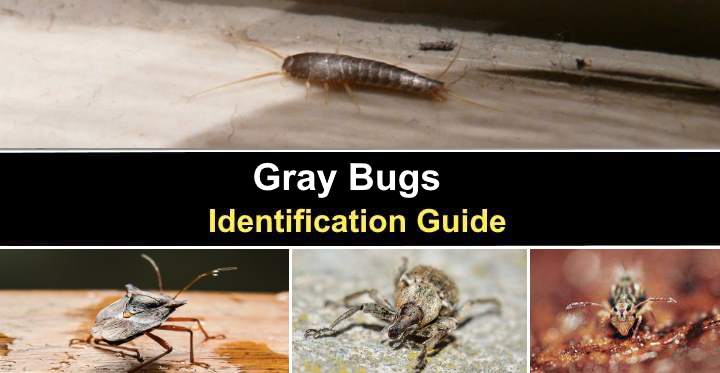
Gray bugs are small annoying creatures that can infest homes. The most common gray bug is the silverfish — a tiny, nocturnal silvery-gray wingless insect seen slithering across bathroom or kitchen floors. Other gray bugs you could find in the home or yard can be stink bugs, gray blister beetles, weevils, or pillbugs.
The sight of any type of gray bug scurrying across the floor is enough to send you into a panic. Thankfully, most gray-colored bugs in the house are harmless because they don’t sting or bite. However, it’s still vital to eliminate these grayish bugs because they may carry disease or infest food in your pantry.
This article is a guide to identifying the most common types of gray bugs in your home or garden. In addition to descriptions and pictures of gray-colored bugs, you will find helpful tips on getting rid of the pesky insects.
How To Identify Gray Bugs in the House
To identify the species of gray bug, note the insect’s shape, patterns, number of legs, and if it has wings. Additionally, the bug’s habits and behavior give tell-tale clues about its identity. Also, consider if the bug is only seen at night or during the day.
For example, silvery-gray bugs like silverfish and pillbugs are typically only found in dark, damp places making them difficult to spot. But other gray bugs may cause a pungent smell when they come inside the home in the fall. However, other bugs are generally only found in the yard.
Types of Gray Bugs (With Pictures) – Identification Guide
Have you spotted a tiny pearly-gray, tear-shaped bug scuttling across the floor? Or maybe you noticed a small, slender gray bug with a long snout, and you don’t know what it is. Whatever the case, please read on to learn more about common gray bugs in your home.
Silverfish (Lepisma saccharina)

Silverfish is a small gray bug commonly found in damp places at home
Silverfish is a tiny silvery, light-gray bug that slithers across the floor with fish-like movements. This tiny wingless insect has a flattened body that appears wider at the head and tapers to the tail end. Closeup pictures of a silverfish show it’s got two large antennae, six legs, and three long bristles at its tail.
Silverfish are tiny, harmless grayish bugs that measure 0.33” (8.5 mm) long. Their characteristic bristle-like appendages are very distinctive. One of the bristles is straight at the tail end, and the other two stick out at right angles. The other end has two extra-long thread-like antennae.
Silverfish are attracted to damp, cool, dark environments. Therefore, you will often find the silvery bugs under kitchen cabinets, in basements, attics and bathrooms. Usually, you will only see the slithering bugs when you disturb their habitat during the daytime.
Silverfish gets its name from its distinctive appearance and habits. The carrot-shaped silvery-gray bug has a metallic appearance like shiny fish scales. Also, you’ll notice that it scuttles across the floor with fish-like movements.
Signs of a silverfish infestation include yellowish stains or tiny black pepper-like droppings on infested countertops or floors. In addition, you may notice feeding marks or holes in linens, clothing, cardboard, or wallpaper. A common sign of the gray bugs is small, tiny transparent skin molts.
Do silverfish bite?
Silverfish are harmless creatures that don’t bite humans. But, although the gray pests don’t carry diseases, they are not pleasant insects to have in your home. And usually, the signs of silverfish indicate issues with dampness or excess moisture in your home.
Although silverfish are not considered dangerous, they can cause allergies. Studies show that their shed bodies and droppings can result in allergic reactions and adverse respiratory symptoms.
How to get rid of silverfish
The best way to get rid of silverfish is to disrupt their habitat. Therefore, it’s essential to identify where your home has moisture problems and resolve those issues. For example, you may need to fix leaky pipes and faulty vents and repair moldy wood. Additionally, a dehumidifier can help reduce moisture problems.
Another way to prevent a silverfish infestation is to store old magazines and newspapers in airtight, sealed containers. Also, silverfish are attracted to starch and sugary foodstuffs. Therefore, it’s necessary to keep flour, sugar, and similar items in airtight containers.
How can you get rid of silverfish? Many people say that cedar oil can help to eradicate silverfish. For example, you could try putting cedar shavings where you’ve noticed silverfish activity. Or you can try spraying surfaces with cedar oil and water.
You could use old, damp newspaper as a trap for eliminating silverfish. You can dampen an old newspaper to attract the silvery-gray bugs. Put the trap where you think silverfish are living. They will then make their homes in the newspaper. After a few days, you can gather up the newspaper and discard it in a sealed plastic bag.
Gray bug identification
Silverfish are identified by their silvery tapered body, fish-like scurrying movements, and long antennae.
Gray Stink Bugs / Shield Bugs
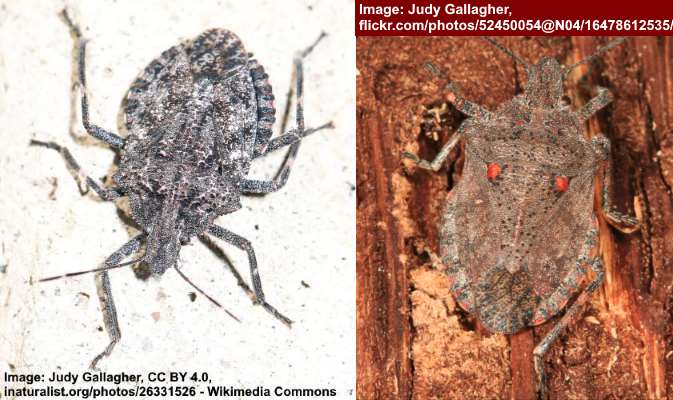
Gray stink bugs / shield bugs: left: Brochymena affinis. Right: Brochymena quadripustulata
Some species of stink bugs have a brownish gray color and a rough, flattened shield-like body. The grayish bugs have recognizable triangular-shaped bodies and mottled patterns on their back. Additionally, gray stink bugs have six long legs and two antennae. The foul-smelling bugs measure 0.67” (17 mm) long and wide.
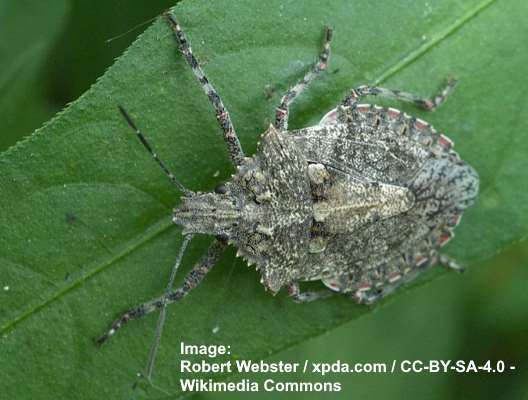
Rough stink bug (Brochymena arborea)
Stink bugs get into homes when the weather becomes cooler in the fall. The stinking gray bugs enter through cracks around window frames, doors, or in the building’s structure. They will set up home in crawl spaces, attics, wall cavities, and basements.
Also called shield bugs due to their distinctive shape, stink bugs have many color variations. The most common is the brown marmorated stink bug (Halyomorpha halys). This pesky insect can be mottled brown, reddish-brown, gray, or black.
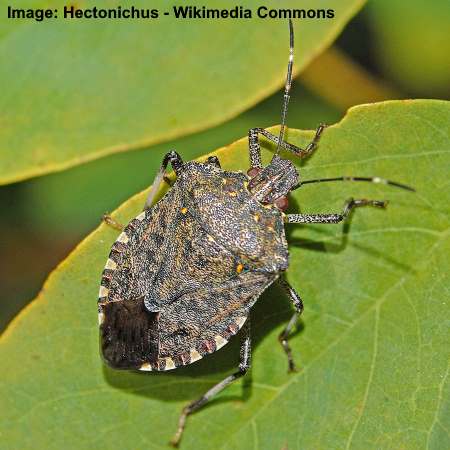
Brown marmorated stink bug (Halyomorpha halys)
Stink bugs are known for the foul odor they emit when threatened or squashed. However, apart from causing a horrific stench, the gray bugs are generally harmless and don’t bite humans or damage property.
The best way to deal with stink bugs is to prevent them from getting into your home in the first place. So, in late summer, inspect your property’s exterior and caulk any cracks around utility pipes, sidings, doors, and windows.
It’s also a good idea to install window and door screens to prevent a stink bug infestation.
The best way of eradicating stink bugs is to use a vacuum cleaner to get rid of them. After vacuuming the bugs, discard the dust bag in the outdoor trash to prevent the disgusting odor from spreading in your home.
Gray bug identification
A gray stink bug has an easily identifiable body in the shape of a shield with gray and white mottled patterns on its back.
Squash bugs (Anasa tristis)
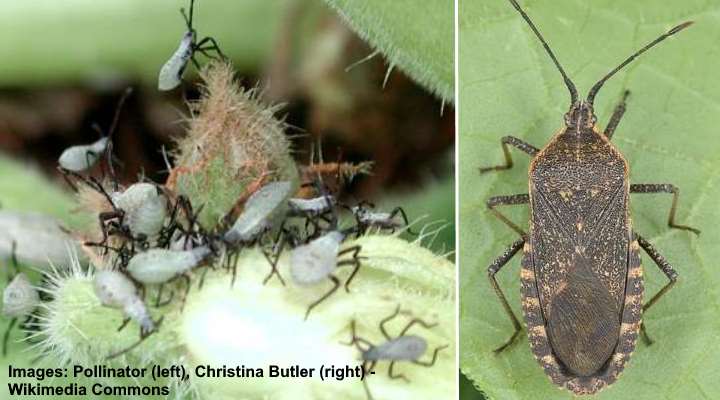
Squash bug nymphs (left) are a light grayish-white color and turn darker gray-brown when they become adults (right)
Squash bugs are dark gray to dark brown creepy crawlies with a flattened oval body. The gray garden pests have alternating brown and orange stripes on their abdomens. Also, grayish-brown squash bugs have six legs and two black antennae. Squash bugs grow 0.6” (15 mm) long and 0.3” (7.5 mm) wide.
Squash bugs live in gardens and vegetable patches and are a significant pest. The grayish bugs infect plants in the Cucurbitaceae family like squash, pumpkins, cucumbers, and bottle gourds. The sap-sucking bugs bite into plant tissue to extract the juices. This feeding activity causes yellow and brown patches on leaves.
Vigilance is crucial in eradicating squash bugs from your garden. The best way to get rid of the gray bugs is to hand pick them from plants and drop them in soapy water.
Another way to eliminate squash bug eggs, larvae, and adults is to make a neem oil solution and use the DIY spray on plant leaves and stems once a week.
It is also helpful to prevent squash bugs from infesting plants. For example, to stop squash bugs from laying eggs, you can use row covers early in the season before pollinators are active.
Gray bug identification
A squash bug is identified by its flattened dark gray-brownish oval body with a recognizable V-shape on its back and tan-colored markings around its edges and near its thorax.
Gray Sunflower Seed Weevil (Smicronyx sordidus)
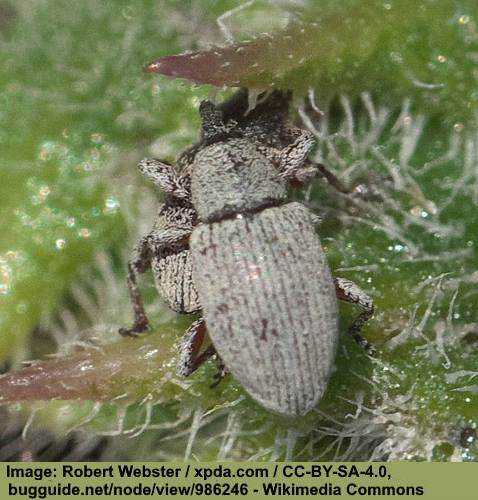
The tiny gray sunflower seed weevil can be found on sunflower plants in the garden
The gray sunflower seed weevil is a strange-looking gray bug with an oval, gray body, long blackish-gray snout, and six legs. The tiny gray bug only measures 0.31” (8 mm) long. The grayish bug is typically found feeding on sunflower plants, and a heavy infestation can destroy an entire plant.
Gray sunflower seed weevils generally don’t invade homes, and you only see them if sunflowers are in the garden.
Other types of weevils can become pests in the home. These are typically brown pantry bugs like the biscuit weevil, rice weevil, maize weevil, and pantry weevil.
Gray bug identification
The gray sunflower weevil has an identifiable oval, rounded gray abdomen, small head, and arched black snout.
Springtail (Collembola)
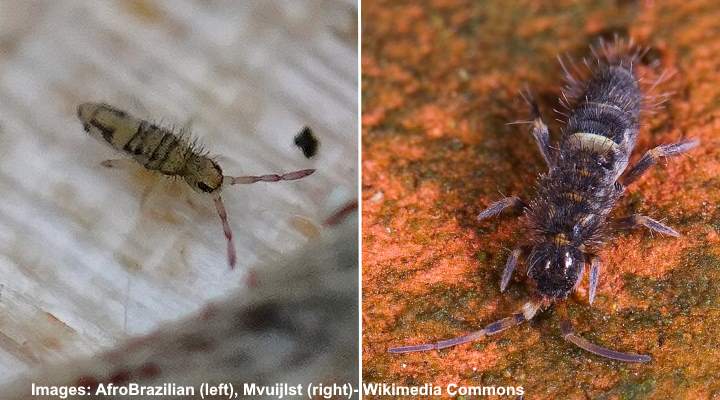
Images of gray springtails: Entomobrya nivalis (left) and Orchesella cincta (right)
Gray springtails are wingless arthropods with a slender gray body, six short legs, and two segmented antennae. The tiny grayish-brown or pale gray bugs are hard to spot as they only measure between 0.07” to 0.16” (2 – 4 mm) long. The minute bugs live in the soil and are never a pest in the home.
Some species of springtails, like the Orchesella cincta, have six-segmented antennae with brown, white, yellow, and black colors. Other tiny bugs like the Entomobrya nivalis have a translucent grayish appearance with pinkish segmented antennae.
Gray bug identification
The gray springtail is identified as a tiny gray arthropod with a slender body, black stripes, and two segmented antennae.
Ashy Gray Lady Beetle (Olla v-nigrum)
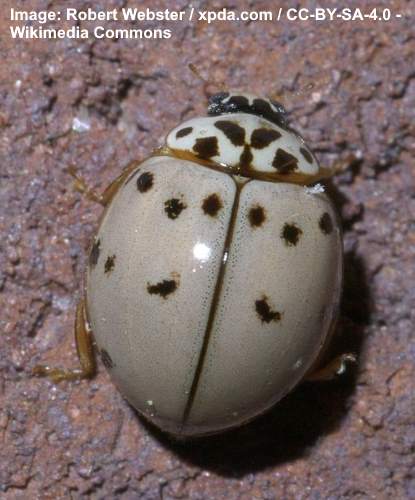
The ashy gray lady beetle is a beneficial insect that feeds on aphids
The ashy gray lady beetle is one of the few bugs in the Coccinellidae family that is gray with black spots. The winged gray insect has pale gray wing covers and a gray thorax and head. In addition, there are several distinctive black spots on its back.
The tiny gray lady beetle measures 0.14” to 0.24” (3.7 – 6.1 mm) long. Most color variations in the species have spotted wing covers; however, some lady beetles have a gray back and heart shape on each side. There is also a type of black and red ladybug that is classified as Olla v-nigrum.
The black-spotted gray ladybug is found throughout North America.
Ashy gray lady beetles feed on aphids and are classified as beneficial insects. Some people who grow crops in greenhouses encourage ladybugs because they help to control aphid populations naturally.
Gray bug identification
The ashy gray lady beetle is easy to recognize with its rounded shape, light grayish-white colors, and black spots on its wing covers.
Little Gray Blister Beetle (Epicauta velata)
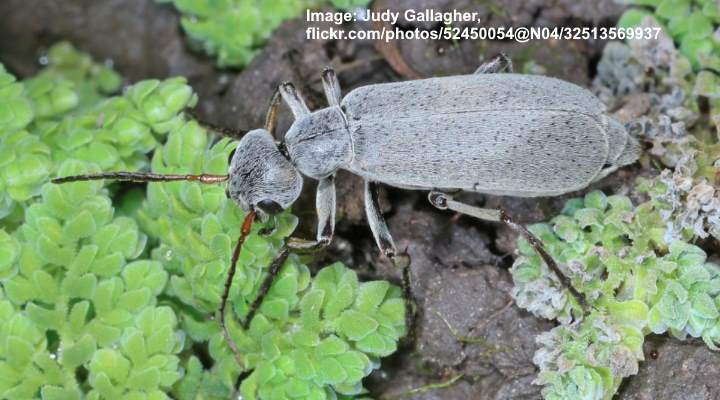
The little gray blister beetle is poisonous and emits a secretion that can cause severe blistering
The little gray blister beetle is a slender, gray-colored insect with two orange and black clubbed antennae and six legs. Like most blister beetles, this gray variety is recognized by its cylindrical abdomen, narrow thorax, and broader head. The little gray blister beetle has a fuzzy gray body and legs and measures 0.47” (12 mm) long.
The gray blister beetle gets its name from the secretions they emit that can cause severe blistering. This makes the gray beetles highly toxic to predators, and ingesting a few of these bugs can cause death in animals.
Blister beetles are rarely a pest in the home. However, they feed on many ornamental plants and nectar from flowers in gardens. The exudation from the beetle when it feels threatened can result in skin irritation, swelling, and blistering. However, the blisters should heal in seven to 10 days.
Gray bug identification
The little gray blister beetle is identified by its slender fuzzy gray body, orange and black antennae, and large black compound eyes on its head.
Pillbugs (Armadillidiidae)
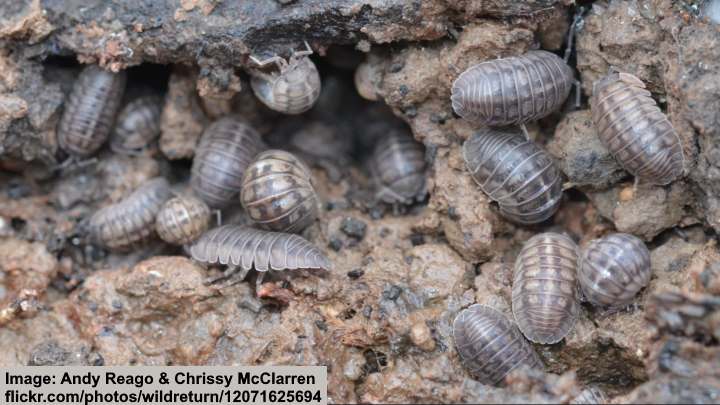
Pillbugs have dark gray hard segmented shell and can roll when they feel threatened
Pillbugs are a type of gray-colored woodlice with a unique segmented hard shell, 14 legs, and two clubbed antennae. The small grayish bug looks like a tiny armadillo. These small bugs have a characteristic habit of rolling into a ball when threatened. Pillbugs grow 0.25” to 0.5” (6 – 12 mm) long.
Pillbugs also go by the names roly polies, doodle bugs, slaters, or potato bugs.
You will usually find pillbugs when you pick large stones, rocks, or move leaf litter. The grayish bugs love dark places and feed on decomposing plant leaves and other decaying organic material. They can also be minor pests in gardens where the gray bugs can feed on plant roots and foliage.
Sometimes, pillbugs can become a pest inside the home, where they tend to congregate in damp, dark areas. However, the gray armadillo-like bugs don’t cause damage and are only a nuisance.
You can quickly get rid of pillbugs from home by sweeping them up and discarding them in the yard. To prevent further entry to the house, caulk up any floor level cracks at door entries or in the foundation. It’s also a good idea to keep decaying plant matter well away from buildings.
Gray bug identification
Pillbugs are easy to identify with their tiny barrel-shaped gray shell that looks like an armadillo and their habit of rolling into a ball for protection.
Related articles:
